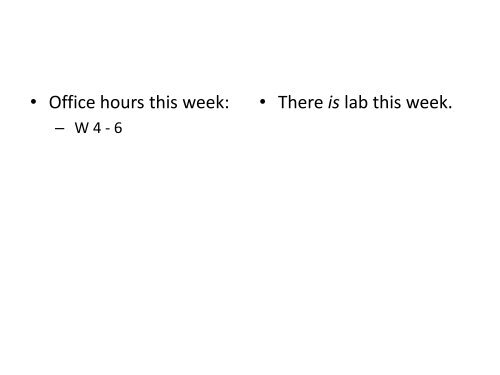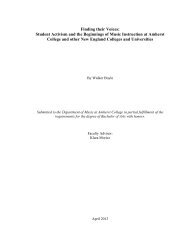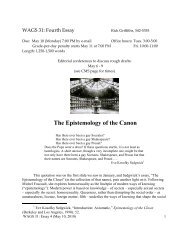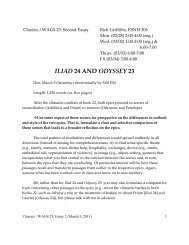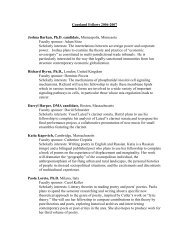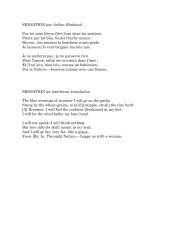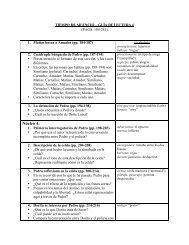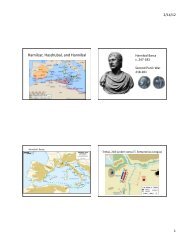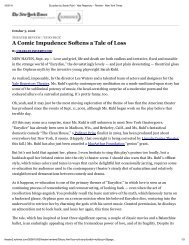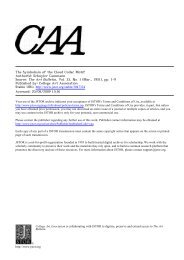A cubical surface with no charge enclosed and with sides 2.0 m long ...
A cubical surface with no charge enclosed and with sides 2.0 m long ...
A cubical surface with no charge enclosed and with sides 2.0 m long ...
You also want an ePaper? Increase the reach of your titles
YUMPU automatically turns print PDFs into web optimized ePapers that Google loves.
• Office hours this week:<br />
– W 4 - 6<br />
• There is lab this week.
Clickers<br />
• IT will collect them here at the end of the last<br />
class.
A <strong>cubical</strong> <strong>surface</strong> <strong>with</strong> <strong>no</strong> <strong>charge</strong> <strong>enclosed</strong> <strong>and</strong> <strong>with</strong> <strong>sides</strong><br />
<strong>2.0</strong> m <strong>long</strong> is oriented <strong>with</strong> right <strong>and</strong> left faces<br />
perpendicular to a uniform electric field E of (1.6 10 5 N/C)<br />
in the +x direction. The net electric flux f E through this<br />
<strong>surface</strong> is approximately<br />
1) zero<br />
2) 6.4 10 5 N · m 2 /C<br />
3) 13 10 5 N · m 2 /C<br />
4) 25 10 5 N · m 2 /C<br />
5) 38 10 5 N · m 2 /C
Which of the following statements contradicts<br />
one of Maxwell's equations?<br />
1) A changing magnetic field produces an<br />
electric field.<br />
2) The net magnetic flux through a closed<br />
<strong>surface</strong> depends on the current inside.<br />
3) A changing electric field produces a<br />
magnetic field.<br />
4) The net electric flux through a closed<br />
<strong>surface</strong> depends on the <strong>charge</strong> inside.<br />
5) None of these statements contradict any of<br />
Maxwell's equations.
Maxwell’s Equations – The Fundamental<br />
Laws of Electromagnetism<br />
• Gauss’ Law<br />
– The total electric flux through a closed <strong>surface</strong> is<br />
proportional to the <strong>charge</strong> <strong>enclosed</strong>:<br />
<br />
ˆ<br />
dA <br />
En <br />
Qencl<br />
• Gauss’ Law for Magnetism<br />
– The total magnetic flux through a closed <strong>surface</strong> is<br />
zero.<br />
– There are <strong>no</strong> magnetic <strong>charge</strong>s.<br />
<br />
Bn <br />
<br />
ˆdA 0<br />
0
The Maxwell-Ampere Law<br />
• The integral of B dl around a closed curve is<br />
proportional to the current piercing a <strong>surface</strong><br />
bounded by the curve plus times the time<br />
rate of change of electric flux through the<br />
<strong>surface</strong>.<br />
<br />
<br />
0<br />
<br />
d<br />
E<br />
Bdl 0Iencl 0<br />
<br />
dt <br />
<br />
Bdl0Iencl <br />
d<br />
0<br />
dt<br />
<br />
ˆ<br />
<br />
EndA <br />
<br />
<br />
Figure 31.3
Faraday’s Law<br />
• The integral of E dl around a closed curve is<br />
proportional the time rate of change of<br />
magnetic flux through a <strong>surface</strong> that is<br />
bounded by the curve.<br />
<br />
<br />
d <br />
Edl BnˆdA dt<br />
<br />
<br />
Figure 29.27c
An ac voltage is applied across a capacitor.<br />
Which figure best represents the magnetic<br />
field between the capacitor plates?
Faraday’s <strong>and</strong> Maxwell-Ampere<br />
Laws<br />
• A changing magnetic flux produces a curly<br />
electric field:<br />
d <br />
Edl BnˆdA dt<br />
<br />
<br />
• A changing electric flux produces a (curly)<br />
magnetic field:<br />
d <br />
ˆ<br />
<br />
Bdl0Iencl0 EndA dt
Self-sustaining fields<br />
• Can electric <strong>and</strong> magnetic fields exist <strong>with</strong>out<br />
any <strong>charge</strong>s or currents around to produce<br />
them?<br />
• Yes, but only if the fields are “moving” (i.e.<br />
changing:<br />
– Electromagnetic waves
A moving “slab” of E <strong>and</strong> B fields<br />
• Thin region in which there are uniform electric <strong>and</strong><br />
magnetic fields.<br />
– No <strong>charge</strong>s or currents in the vicinity of the slab.<br />
– Outside the slab, both fields are zero.<br />
– Inside the slab, E <strong>and</strong> B are perpendicular to each other.<br />
– Slab moves in a direction perpendicular to both fields.<br />
E<br />
B<br />
E<br />
v v<br />
B<br />
front view top view<br />
E<br />
B<br />
v
Slab obeys Gauss’ Laws for E <strong>and</strong> B<br />
E<br />
B<br />
v<br />
<br />
ˆ<br />
dA <br />
En <br />
<br />
Bn <br />
Qencl<br />
<br />
ˆdA 0<br />
0
A <strong>cubical</strong> <strong>surface</strong> <strong>with</strong> <strong>no</strong> <strong>charge</strong> <strong>enclosed</strong> <strong>and</strong> <strong>with</strong> <strong>sides</strong><br />
<strong>2.0</strong> m <strong>long</strong> is oriented <strong>with</strong> right <strong>and</strong> left faces<br />
perpendicular to a uniform electric field E of (1.6 10 5 N/C)<br />
in the +x direction. The net electric flux f E through this<br />
<strong>surface</strong> is approximately<br />
1) zero<br />
2) 6.4 10 5 N · m 2 /C<br />
3) 13 10 5 N · m 2 /C<br />
4) 25 10 5 N · m 2 /C<br />
5) 38 10 5 N · m 2 /C
E<br />
Does Slab obey Faraday’s Law?<br />
B<br />
d <br />
Edl BnˆdA dt<br />
<br />
<br />
E<br />
v v<br />
B<br />
front view
Does Slab obey Maxwell-Ampere<br />
E<br />
B<br />
Law?<br />
v E<br />
v<br />
B<br />
top view<br />
d <br />
ˆ<br />
<br />
Bdl0Iencl0 EndA dt


